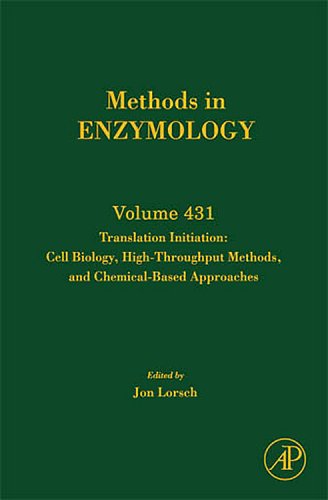Translation Initiation Cell Biology High throughput and Chemical based Approaches 1st Edition by Jon Lorsch ISBN 0123739640 9780123739643 by Jon Lorsch 9780080553481, 9780123739643 instant download after payment.
Translation Initiation Cell Biology High throughput and Chemical based Approaches 1st Edition by Jon Lorsch - Ebook PDF Instant Download/Delivery: 0123739640, 9780123739643
Full download Translation Initiation Cell Biology High throughput and Chemical based Approaches 1st Edition after payment

Product details:
ISBN 10: 0123739640
ISBN 13: 9780123739643
Author: Jon Lorsch
Translation Initiation Cell Biology High throughput and Chemical based Approaches 1st Table of contents:
Part I: The Cell Biology of Translation Initiation
Chapter 1: Fundamentals of Eukaryotic Translation Initiation
- Overview of the Central Dogma and Protein Synthesis
- Ribosome Structure and Function (40S, 60S, 80S subunits)
- The mRNA Template: Cap, UTRs, and Coding Sequence
- Key Eukaryotic Initiation Factors (eIFs): Structure and General Function
- The Canonical Pathway: Cap-Dependent Initiation
- eIF4F Complex (eIF4E, eIF4G, eIF4A)
- Ribosome Recruitment (eIF3)
- Scanning and AUG Recognition
- 60S Subunit Joining
- Regulation of Canonical Initiation: Phosphorylation, Availability of eIFs
Chapter 2: Alternative Modes of Translation Initiation
- Internal Ribosome Entry Site (IRES)-Mediated Translation
- Discovery and Characteristics of IRES Elements
- Mechanisms of IRES-Dependent Initiation (eIF-dependent vs. eIF-independent)
- Physiological and Pathological Roles of IRESs (e.g., viral translation, stress response)
- Leaky Scanning and Re-initiation
- Definition and Mechanisms
- Roles in Gene Regulation (e.g., uORFs)
- Non-AUG Initiation
- CUG, GUG, and Other Non-Canonical Start Codons
- Mechanisms and Biological Significance
Chapter 3: Regulation of Translation Initiation in Cellular Processes
- Stress Responses:
- Integrated Stress Response (ISR) and eIF2α Phosphorylation
- mTOR Pathway and eIF4F Regulation (4E-BP, S6K)
- Hypoxia and Nutrient Deprivation
- Cell Cycle Control and Proliferation
- Development and Differentiation
- Neuronal Plasticity and Memory Formation
- Viral Infection: Host Shutoff and Viral Takeover of Translation Machinery
Chapter 4: Pathological Roles of Dysregulated Translation Initiation
- Cancer: Aberrant eIF Expression, mTOR Pathway Activation
- Neurological Disorders: Fragile X Syndrome, Alzheimer's, Parkinson's (e.g., FMRP, eIF2α)
- Metabolic Diseases: Diabetes, Obesity
- Viral Pathogenesis: Exploitation and Evasion Strategies
- Rare Genetic Disorders Linked to eIF Mutations
Part II: High-throughput Approaches to Study Translation Initiation
Chapter 5: Ribosome Profiling (Ribo-seq)
- Principles and Methodology of Ribo-seq
- Polysome Footprinting and Deep Sequencing
- Computational Analysis: P-site Determination, Translation Efficiency
- Applications in Translation Initiation Research:
- Identifying Translation Start Sites (TSS) and Alternative Open Reading Frames (ORFs)
- Mapping Ribosome Movement and Translation Rates
- Investigating Context-Dependent Initiation (e.g., uORFs, non-AUG)
- Advantages and Limitations of Ribo-seq
Chapter 6: Other Omics-based Approaches
- Translational State-Dependent RNA Sequencing (TRAP-seq, RiboTag)
- Mass Spectrometry-Based Proteomics for Quantifying Newly Synthesized Proteins
- Chemical Proteomics for Profiling eIF Interactions and Modifications
- CRISPR-based Screens to Identify Genetic Regulators of Initiation
- Quantitative Imaging Techniques for Visualizing Translation in Live Cells
Chapter 7: Computational and Bioinformatics Tools for Initiation Analysis
- Software and Algorithms for Ribo-seq Data Analysis
- Prediction of IRES Elements and Regulatory Motifs
- Databases of Translation Initiation Sites and Regulatory Elements
- Network Analysis of Translation Regulatory Pathways
Part III: Chemical-based Approaches and Therapeutic Interventions
Chapter 8: Small Molecule Modulators of Translation Initiation
- Inhibitors Targeting Canonical Initiation:
- eIF4A Inhibitors (e.g., Rocaglates, Hippuristanol)
- eIF4E Inhibitors
- eIF2α Kinase Inhibitors
- mTOR Inhibitors (Rapamycin and Analogs)
- Modulators of IRES-Mediated Translation
- Compounds Affecting Ribosome Biogenesis and Function
- Strategies for High-Throughput Screening of Initiation Modulators
Chapter 9: Chemical Biology Tools for Probing Initiation Mechanisms
- Photo-Crosslinking Approaches for Mapping RNA-Protein Interactions (e.g., CLIP-seq variants)
- Chemical Probes for Visualizing Translation Initiation Events
- Bioorthogonal Labeling Strategies for Tracking Nascent Proteins
- Tools for Studying eIF Modifications and Dynamics
Chapter 10: Therapeutic Strategies Targeting Translation Initiation
- Translation Initiation as a Drug Target in Cancer:
- Targeting eIF4F Axis
- Repurposing Existing Drugs
- Antiviral Strategies: Exploiting Differences in Host vs. Viral Translation
- Therapeutic Approaches for Neurological and Metabolic Disorders
- Challenges and Opportunities in Drug Development Targeting Translation Initiation
- Specificity, Off-Target Effects, and Resistance Mechanisms
Chapter 11: Gene Therapy and Nucleic Acid-Based Approaches
- Antisense Oligonucleotides (ASOs) and siRNA for Modulating eIF Expression
- mRNA-based Therapeutics and Their Reliance on Efficient Initiation
- CRISPR/Cas9 for Engineering Regulatory Elements (e.g., uORFs, IRESs)
- Ribozymes and Aptamers as Modulators of Initiation
Conclusion
- Synthesis of Key Discoveries and Emerging Themes
- Bridging the Gap: Integrating Cell Biology, High-throughput, and Chemical Approaches
- Future Directions in Translation Initiation Research:
- Single-Cell Resolution Studies
- In Vivo Imaging of Translation
- AI/Machine Learning in Predicting Regulatory Mechanisms
- Development of Novel Therapeutic Modalities
People also search for Translation Initiation Cell Biology High throughput and Chemical based Approaches 1st:
translation biology initiation
translation initiation definition biology
translation initiation explained
translation initiation diagram
initiation biology translation
Tags: Jon Lorsch, Translation, Initiation



